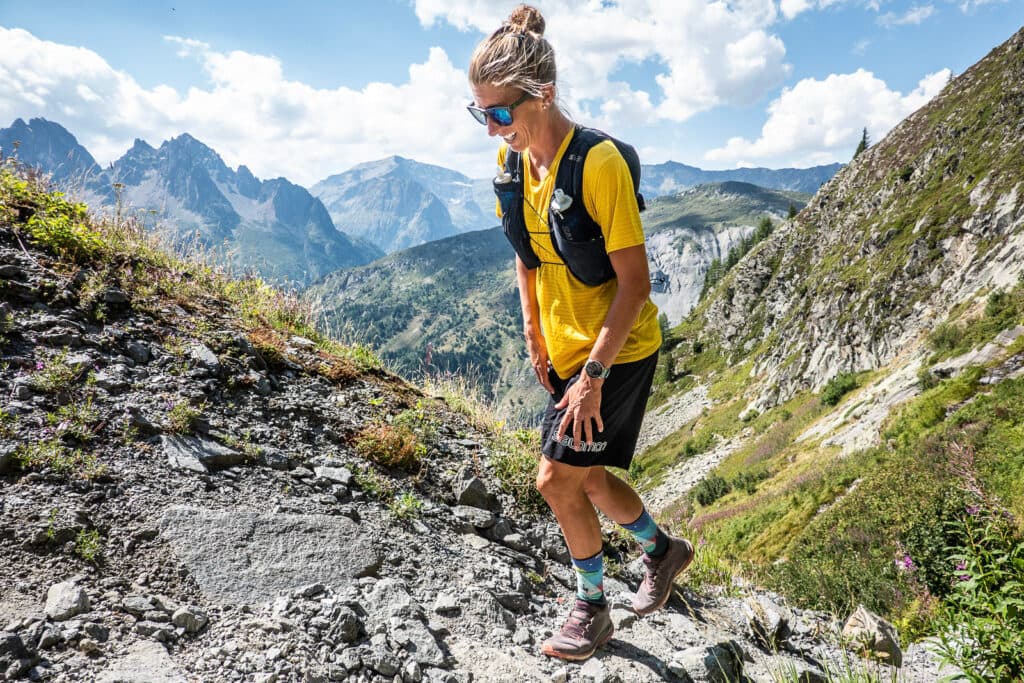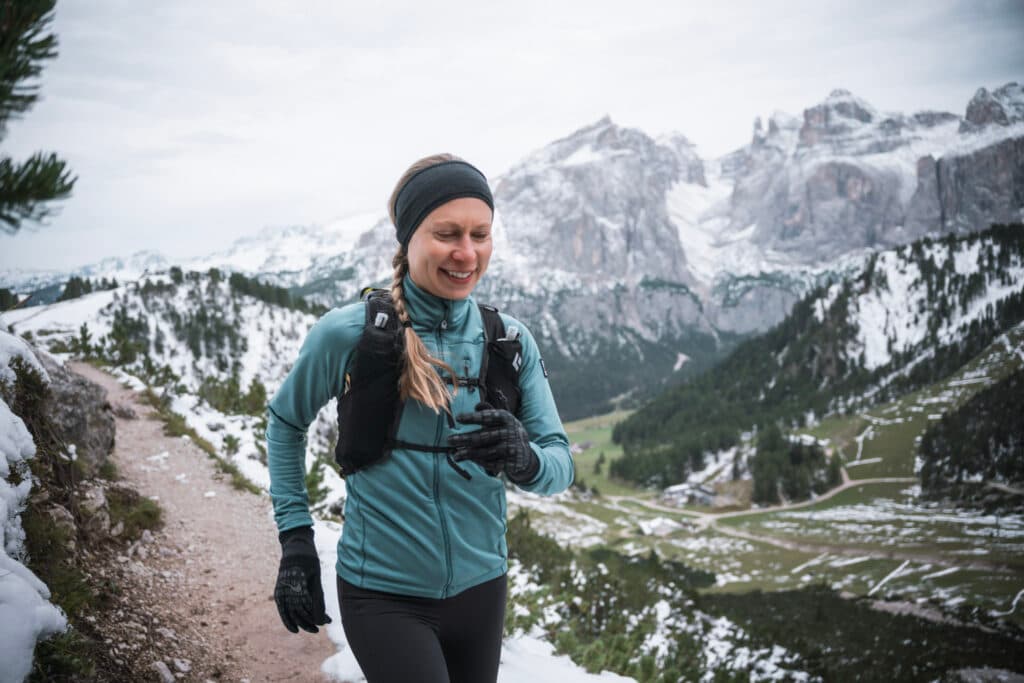

Here for the Women’s Race: From Aspiration to Reality
Lead photo: Kim Strom
Plastered across a t-shirt, written into social media captions, or shouted from the sidelines of a race, you’ve probably come across the phrase “here for the women’s race” if you’ve been following the trail and ultrarunning scene over the past year or so. What started as a simple slogan has now become a broader movement to elevate women’s visibility in trail running through media, storytelling, and intentional support.


When it was first launched by the Pro Trail Runners Association at the 2024 Western States Endurance Run, I saw it as a battle cry—a call to industry leaders, brands, producers, media, and race directors to pay more attention to women in endurance running. Women are historically underrepresented in trail running, particularly in the longer distances, comprising just 16 and 18 percent of runners in the 100-mile and 100km categories last year, according to data from the International Trail Running Association. While participation rates are increasing, particularly in the shorter distances, it is perhaps no surprise that women’s stories of grit, triumph, and tenacity have not garnered the same coverage or recognition as men’s. Proclaiming that we were actively here for the women’s race—not just passively watching—felt like a bold, effective way to demand equity and push for greater representation in our sport.
But after having had the chance to commentate on a number of races in the UTMB® World Series, my perspective has evolved. Rather than a cry for change, “here for the women’s race” now feels like an affirmation of where we’ve arrived.

Gaining Ground Fast
Covering the women’s race has genuinely become more compelling than the men’s. I’ll say it outright: the biggest stories in trail and ultrarunning today are coming from the women’s field. We’re witnessing record-breaking performances, historic milestones, and a surge in competition.
Women in trail and ultrarunning are gaining ground fast—and I mean that literally. Thanks to steadily increasing participation over the past two decades, the talent pool is deeper than ever. According to a comprehensive study by Run Repeat in 2022 covering more than 15 million race results, women’s participation in trail running has grown from 13 percent in 1997 to 46 percent in 2022. More women on the start line means more fierce competition, more inspiration, and more momentum. With that momentum comes progress: not just in times and trophies, but in how women’s racing is viewed, valued, and covered.
Take, for example, the finishing times at the Ultra-Trail du Mont Blanc (UTMB) since its inception in 2003. Excluding years where the course was significantly altered, men’s winning times have ranged from 19:37 to 22:00—fluctuating by less than 2.5 hours over two decades. The women’s winning times, on the other hand, have dropped dramatically—from 29:38 in 2003 to 22:09 in 2024 by Katie Schide—a staggering improvement of almost eight hours since the race’s start, and 21 minutes over Courtney Dauwalter’s 2021 record. The bar is still rising, and we’re watching it happen in real time.
Importantly, the women pushing these boundaries aren’t isolated outliers. Yes, Courtney remains a phenomenon in her own right. After turning professional in 2017, she dominated everything from 50Ks to 280-mile races, often winning outright and smashing course records. She became Ultrarunner of the Year in 2018 and held the title up through 2023. Her performances were so far ahead of the field that, for a time, it was tempting to view her as a once-in-a-generation anomaly – someone whose dominance said more about her individual brilliance than it did about the women’s field as a whole.
I remember coming second to Courtney at Hardrock 100 in 2021, a full seven hours behind her record-setting time. As proud as I was of my own race, the gap only underscored how extraordinary Courtney’s performance was. It was easy then to think of her success as an exception, not a broader sign of change.
But that’s no longer the case.

Courtney is still blazing trails, but she isn’t out there alone. The women’s field has grown stronger, deeper, and more competitive. We are witnessing a generation of women stepping up, showing up, and shaking up the sport. Athletes like Katie Schide, who broke Courtney’s course record at UTMB last year and secured the title of Ultrarunner of the Year; Tara Dower, who set a blistering Fastest Known Time on the Appalachian Trail last year; and Jasmin Paris, who made history as the first woman to finish the Barkley Marathons in its 38-year history, are all helping redefine what’s possible.
With more women competing, we’re also seeing a richer diversity in the stories being told. More races now offer pregnancy deferral policies, which allow women to better plan for childbirth and postpartum recovery without giving up their racing ambitions. Athletes like Sophie Power, who famously breastfed mid-race at UTMB in 2018, helped spark long-overdue conversations about what support female athletes need—not just to compete, but to thrive.

Not Finished
Yet amidst all this progress, it would be remiss not to acknowledge where we still fall short.
Women from racial and ethnic minority backgrounds remain grossly underrepresented—not just on the trail, but in race coverage, sponsorship, and leadership roles. Research by the Running Industry Diversity Coalition has found that Black, Indigenous, and other people of color (BIPOC) trail runners hold significant concerns around barriers to access, safety and inclusion in trail running competitions. Meanwhile, trans women face increasing legislative and institutional challenges that threaten their right to compete. Groups like the Black Trail Runners and Queer Runnings in the United Kingdom, and Native Women Run, Latinos Run, and Out Trails in the United States are working to promote and defend inclusion in sport, but deep inequity persists.
While we’ve made important gains for women in trail and ultrarunning, the benefits are not equally shared. Representation must be intersectional if we truly want to build an inclusive and equitable sport. Until we see more BIPOC and transgender women runners celebrated and supported in trail running, the work isn’t finished.

What does “here for the women’s race” mean now?
So, just what does “here for the women’s race” mean now? It means showing up for women athletes with the same energy, interest, and investment we’ve long reserved for the men, whether as a spectator, a competitor, a race director, a sponsor or a journalist. It means making space in our sport for more women’s stories to be told, not just the ones that mirror dominant narratives.
But more than anything, it means recognizing that the women’s race is the race. The front pack, the course records, the comebacks, the battles—it’s all there. And it’s thrilling to watch.
We’re not just here for the women’s race because it’s the right thing to do. We’re here because it’s the most exciting show in town.

ITRA’s Women’s Trail Day
On June 1, 2025 ITRA is prompting a global celebration of women hitting the trails together — to connect, enjoy, and champion female participation in trail running. Women around the world will take to the trails — not for time or trophies, but to celebrate what it means to move together.
Join the Strava Event from wherever you run in the world!
Celebrating Women’s Trail Day in Chamonix
In Chamonix, France – join us on June 1 for an in-person celebration of Women’s Trail Day with a relaxed 7km group trail run.
Event Details:
Date & Time: Sunday, June 1st at 11:00 AM
Start Location: Big Mountain Brewery, Chamonix












Celebrating women- our guides, guests, and friends on Run the Alps’ tours. (Photos: Sam Hill, Kim Strom, Martina Valmassoi, Aleksandra Janiak.